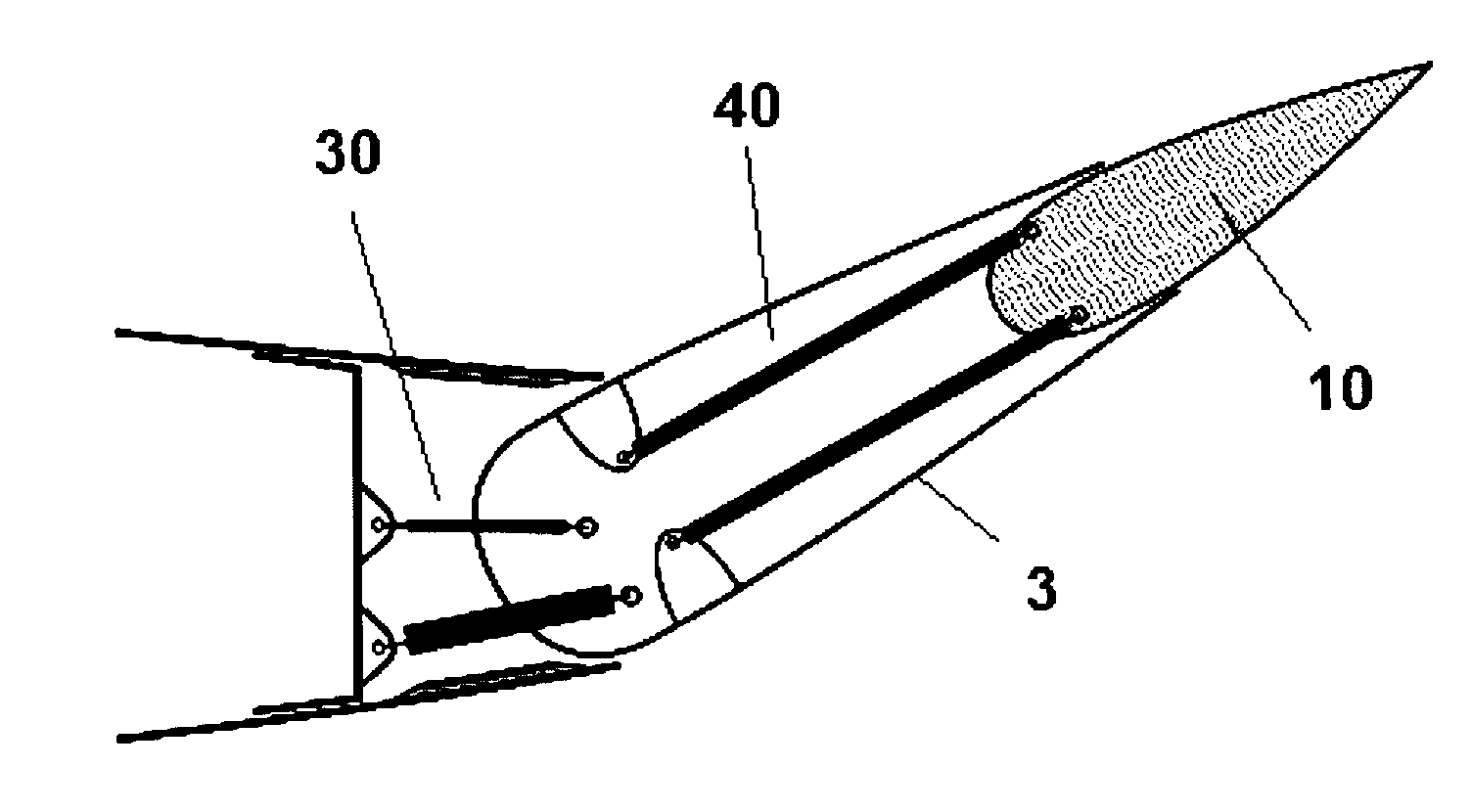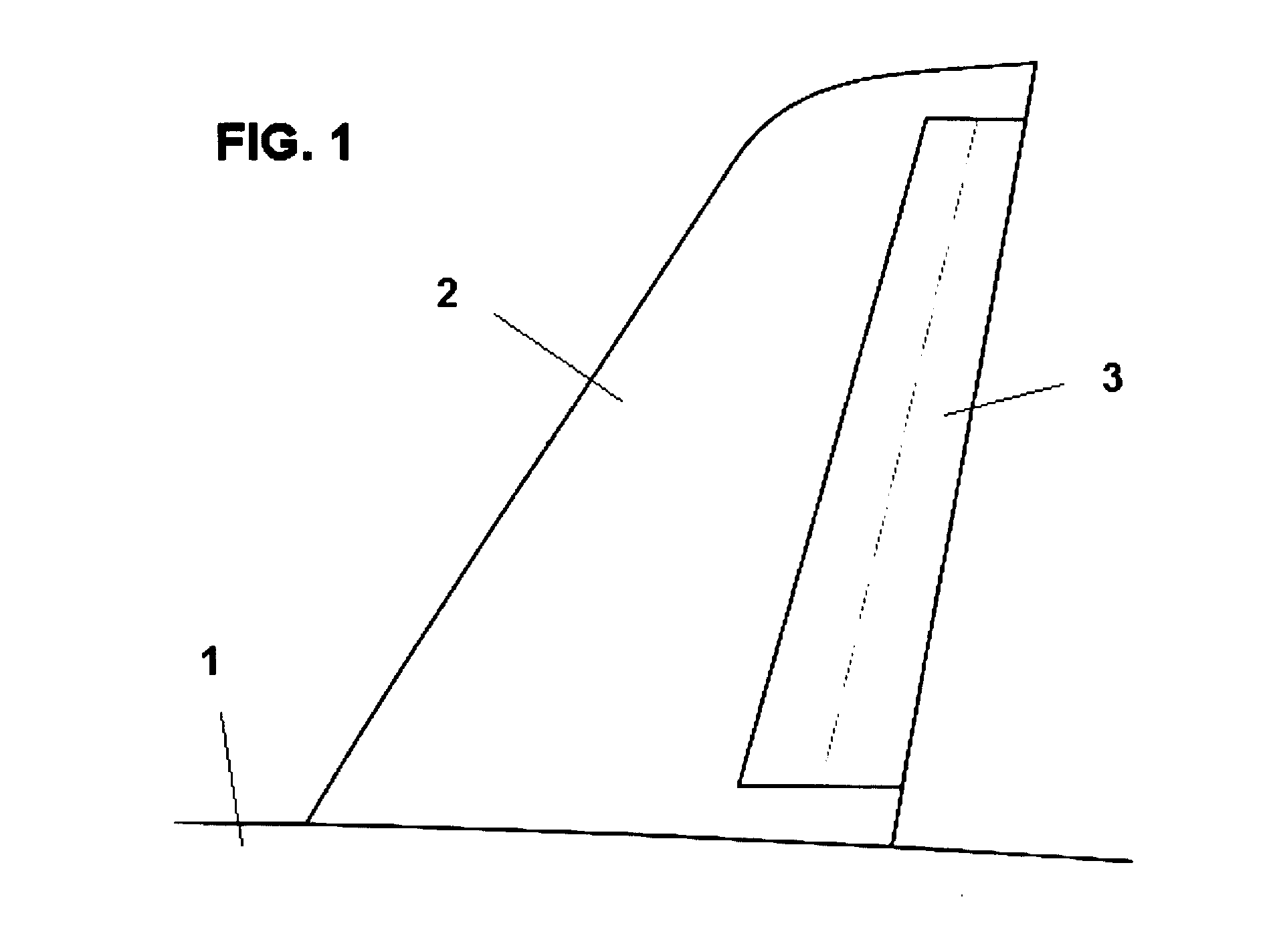Stabilizing and directional-control surface of aircraft
a technology of directional control and aircraft, which is applied in the direction of metal working apparatus, transportation and packaging, weapons, etc., can solve the problems of increasing the complexity of the aircraft and its flight control system structure, increasing fuel consumption and noise, and increasing the weight and drag of the aircraft, so as to improve the energy efficiency and reduce the time for centring the aircraft. , the effect of increasing the weight of the uni
- Summary
- Abstract
- Description
- Claims
- Application Information
AI Technical Summary
Benefits of technology
Problems solved by technology
Method used
Image
Examples
first embodiment
[0033]FIGS. 3a and 3b show two positions, in a schematic top view, of the rudder 3 of an aircraft, in retracted mode, according to the present invention. The two positions of the rudder 3 in FIGS. 3a and 3b are: without being deflected (or deflection 0°) in FIG. 3a, and deflected in FIG. 3b. These figures also show part of the plan view of the vertical stabilizer 2 and of its torsion box-beam 4. The rudder 3 is anchored on the surface of the vertical stabilizer 2 in a conventional manner. Thus, we have a deflecting system 30 that comprises at least two actuators 7, with each actuator 7 anchored to the torsion box-beam 4 of the vertical stabilizer 2 by means of a fitting of type 8, and to the rudder 3 by means of a catch 9. The deflecting system 30 provides the appropriate deflection of the rudder 3. Rudder 3 comprises in its turn an internal profile 10, a fundamental structure for increasing the aerodynamic surface area on extension of the rudder 3.
[0034]FIGS. 4a and 4b show two pos...
second embodiment
[0038]As can be seen in FIGS. 5a and 5b, corresponding to the present invention, it comprises an actuating system 40 for the extension and retraction of the internal profile 10 of the rudder 3 that comprises at least one actuator 57, said actuator 57 being anchored to the structure of the rudder 3 by means of a fitting of type 58, and to the internal profile 10 of the rudder 3 by means of a catch 59. By means of the aforementioned actuating system 40, it is possible to extend and retract the internal profile 10 and therefore increase or reduce the aerodynamic surface of the rudder 3 in relation to the circumstances explained previously.
[0039]This second embodiment of the invention (FIGS. 5a and 5b) further incorporates a guidance system 17 which guides the movement of the internal profile 10 of the rudder 3. The guidance system 17 comprises a system of bearings 18 and a bar 19. The bar 19 is connected to the internal profile 10, so that when the actuating system 40 induces a transla...
third embodiment
[0043]Thus, the operation of FIGS. 6a and 6b corresponding to the invention will consist of extension and retraction of the rudder 3 by means of the elastic system 20 and the cable-controlled movement system 21, aided by the guidance system 17. In this way, when it is necessary to extend the rudder 3 of the vertical stabilizer 2 based on the flight requirements, the movement of the cable 22 will be released in the motor 23, so that the elastic system 20 will be activated and will produce a fast movement of the internal profile 10, but moreover a movement that is controlled by the guidance system 17, with the result that the rudder 3 assumes its extended configuration. When the flying conditions permit the area of the vertical stabilizer 2 to be reduced, the internal profile 10 will be retracted by take-up of the cable 22, through actuation of motor 23. Both the movement of extension and that of retraction of the internal profile 10 of the rudder 3 will be controlled by the guidance ...
PUM
 Login to View More
Login to View More Abstract
Description
Claims
Application Information
 Login to View More
Login to View More - R&D
- Intellectual Property
- Life Sciences
- Materials
- Tech Scout
- Unparalleled Data Quality
- Higher Quality Content
- 60% Fewer Hallucinations
Browse by: Latest US Patents, China's latest patents, Technical Efficacy Thesaurus, Application Domain, Technology Topic, Popular Technical Reports.
© 2025 PatSnap. All rights reserved.Legal|Privacy policy|Modern Slavery Act Transparency Statement|Sitemap|About US| Contact US: help@patsnap.com



